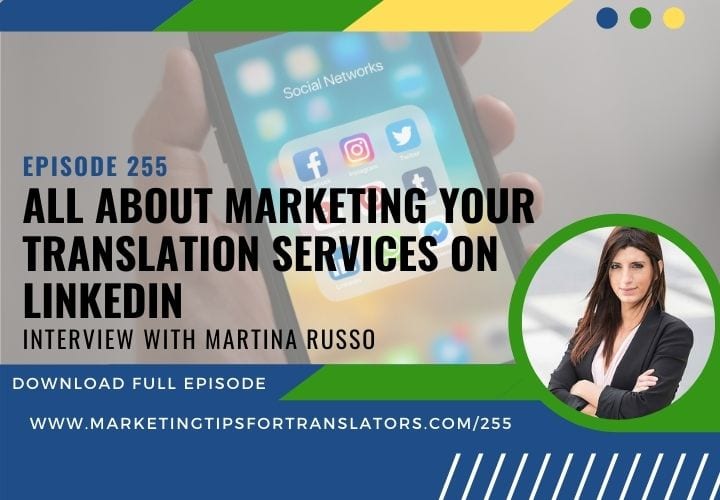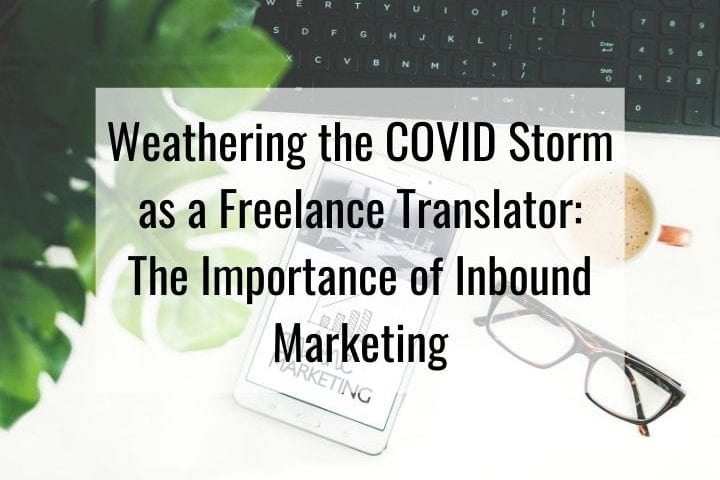
Episode 254: All About Pricing Your Translation Services – Interview with Susie Jackson
08/24/2020
Episode 255: All About Marketing Your Translation Services on LinkedIn – Interview with Martina Russo
09/07/2020Are you swamped with work? Work that you enjoy and with clients you love working with? If so, congratulations.
However, if you wish that more clients found you and that you could be more targeted in your approach, then read on.
As someone who lives a long way from my clients, I don’t have a lot of opportunities to take advantage of in-person networking or seminars—a fact only exemplified by COVID.
Apart from reaching out to our clients ourselves, we can make sure that our online platform is set up so that the companies and clients that DO need our services can easily find us online, plus use content marketing to attract them to us. This is also called inbound marketing.
What Is Inbound Marketing?
Hubspot, one of the world’s biggest proponents of inbound marketing (and content marketing), defines it as: “[A] business methodology that attracts customers by creating valuable content and experiences tailored to them.” Unlike ads and other outbound tactics, this form of marketing puts you in the role of advisor and friend. It focuses more on being helpful and nurturing long-term relationships than on making a quick buck. Strategies are often passive and include things like monthly blogging, quarterly newsletter writing, and regular posting on social media. But you’d be wrong to think that its unobtrusiveness makes inbound less effective than traditional methods. Studies have found it to be:
- Cheaper: Inbound leads cost roughly 60% less than those obtained through outbound means like direct response campaigns. This saves the average business $14 for each customer acquired.
- A Conversion Machine: Properly executed inbound marketing can be up to 10 times as effective at converting than outbound campaigns of equivalent size. Over 80% of marketers that blog report a positive ROI. Additionally, companies that make the switch, on average, report having 54% more leads to convert. That’s a big deal!
- More in Line With What Customers Want: Do you have an ad blocker on your browser? Are you someone who fast forwards through commercials on DVR? Are pop-up ads enough to make your eye twitch? If you answered “yes” to any of these, then inbound marketing might be more your speed. And, if so, you’re not alone. Invesp found that “80% of business decision-makers prefer to get company information in a series of articles versus an advertisement.”
Related: Inbound vs. Content Marketing for Translators
The Inbound Marketing Process
Unlike outbound marketing, which is often graphed as a funnel, inbound marketing is more of a self-propelling loop. Though best viewed as a continuous process, experts split inbound into three to four separate stages:
- Attract: This step is all about attracting potential translation clients to your website. After all, if you don’t have visitors, you can’t engage or delight them. To succeed in attracting customers, you need to create content they find useful. Blogging, social media posting, and SEO are often found at this step. However, it takes some time to see results. Commit to sharing helpful resources and tips that help your customers save money and answer common translation questions. Be aware that attractive content shouldn’t be about you—even if you’re an influencer in your target language. Put yourself in your customer’s shoes and focus on what they want.
- Convert: Now that the stranger is a visitor, you have to get them to express some interest in buying your product—usually by collecting contact information. Once that’s done, that person transitions from visitor to lead. But, in this age of hyper privacy, how do you get them to hand over their email? You can simply ask them to email you, once they’ve landed on your website, or better yet, create some interesting and useful material in the form of a guide that they can get in exchange for their email address.
- Close: Now, it’s time to close the deal and start getting a return on your investment. Please know that closing isn’t easy—it can take more than 10 interactions with most leads before they transition to customers. Selling more comprehensive or expensive translation services? Expect that number to go up proportionally. To help close the deal, use things like email marketing and personalized follow-ups.
- Delight: To keep your marketing momentum going, you should aim to transform your translation clients into brand ambassadors. This means engaging regularly with your clients and doing everything you can (within reason) to exceed their expectations. Tools employed at this stage include follow-up emails, tips and tricks, thank you letters, and satisfaction surveys. Just don’t go overboard on the after-purchase touchpoints. Acting like a buzzing fly will decrease the chance of them being a repeat customer and lose you any chance at a recommendation.
Three Steps Translators Can Take to Use Inbound Marketing
Ready to start marketing your translation services the inbound way? Great! Follow the three steps below:
- Narrow down: While it is tempting to be open to work with anyone and in any subject, it will make it much harder to attract clients and use inbound marketing. It not only spreads you thin but also muddles your marketing, diminishes your expertise, and opens you up to quality issues. To make it easier for yourself and the client, it is best to narrow down to a specific industry or subject area. What subjects and markets are you passionate about? What do you have experience with? Once you’ve found your niche, you need to define your target market and build a buyer persona. Focus on what issues your clients are having and what parts of the internet they frequent (probably LinkedIn). Once these things are done, you can go on to step two.
- Build and Optimize Your Online Presence: To grow a thriving freelance business, you need to be readily available online. You also need to be laser-focused on being where your customers are. When it comes to this stage of inbound, I’d suggest starting with your website. If you have one, make sure it’s optimized for what your customers are searching for and written in a way that focuses less on how you can help them. If you don’t have a website for your translation services, get one, even a one page one is a good start. Make sure to display your testimonials, certifications, and experience in a prominent place. Then, you can get to work on creating social media accounts on the sites your customers frequent. With all that done, you can finally start posting.
- Report and Adjust: So, how will you know when your inbound marketing efforts bear fruit? You’ll have to track them! Use a tool like Google Analytics to monitor your website traffic. I suggest setting aside an hour or two per month to analyze your current performance. See what pages receive the most views, where customers tend to drop off in the buying process, what kind of people end up filling out your contact forms, and where those leads coming from. Are there any questions you get over and over again? Did a process fail you earlier in the month? This reflection time will allow you to chart a new, more profitable course and keep your momentum going.
Related: How to Use Inbound Marketing to Attract Translation Clients
Would You Like to Improve Your Online Presence and Start Using Inbound Marketing?
There’s no better time than now to review your online presence and make sure you are attracting your ideal clients. If you want more tips on how to narrow down, what content to use on your website, how to optimize your online profiles on LinkedIn and other platforms, you can learn more in a webinar I’ve created that you can watch on-demand. You’ll get tips on how to use the right content to engage with prospects online, plus tips and tools to make the process faster and easier.
In less than an hour with me you’ll both review the above information and learn:
- The basic characteristics of freelance translation buyer personas and additional tips you can use to develop your own
- Strategies you can use to optimize your website design and convert leads into customers
- The specific tools I use to analyze my translation marketing and its effectiveness
- The type of content I share with my translation clients and the type of things that do well with B2B customers
Sound good? Click below to get access to this webinar. This one is absolutely free to watch and I hope you find it helpful.



